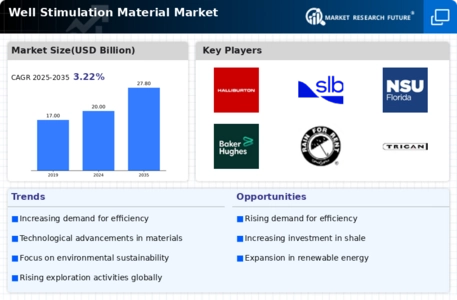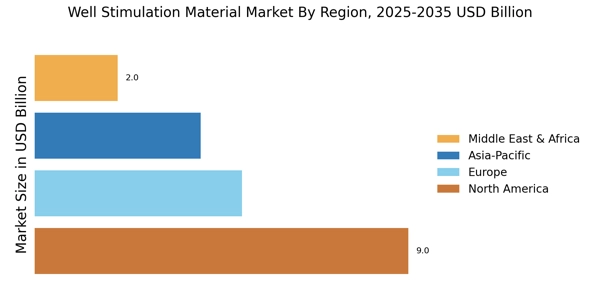Rising Energy Demand
The Well Stimulation Material Market is experiencing a surge in demand due to the increasing global energy requirements. As economies expand and populations grow, the need for efficient energy sources becomes paramount. This trend is particularly evident in regions where traditional energy sources are being supplemented by unconventional oil and gas extraction methods. The International Energy Agency projects that global energy demand will rise by 30% by 2040, necessitating advanced well stimulation techniques. Consequently, the demand for well stimulation materials, which enhance the extraction process, is likely to increase significantly. This growth is expected to drive innovation and investment in the sector, as companies seek to optimize production and meet the rising energy needs.
Technological Innovations
Technological advancements play a crucial role in shaping the Well Stimulation Material Market. Innovations in materials science and engineering have led to the development of more effective stimulation materials, such as advanced proppants and chemical additives. These innovations not only improve the efficiency of well stimulation processes but also enhance the overall recovery rates of oil and gas. For instance, the introduction of smart materials that can adapt to downhole conditions is revolutionizing the industry. According to recent studies, the use of these advanced materials can increase recovery rates by up to 20%. As technology continues to evolve, the market for well stimulation materials is expected to expand, driven by the need for more efficient and sustainable extraction methods.
Focus on Enhanced Oil Recovery
The emphasis on Enhanced Oil Recovery (EOR) techniques is a significant driver for the Well Stimulation Material Market. As conventional oil reserves deplete, operators are increasingly turning to EOR methods to extract additional resources from existing fields. These techniques often require specialized stimulation materials to improve the efficiency of the recovery process. The market for EOR is projected to grow substantially, with estimates suggesting a compound annual growth rate of over 10% in the coming years. This growth is likely to be accompanied by an increased demand for well stimulation materials that can effectively support these advanced recovery methods, thereby driving market expansion.
Regulatory Support for Oil and Gas
The Well Stimulation Material Market is benefiting from favorable regulatory frameworks that support oil and gas exploration and production. Governments are increasingly recognizing the importance of energy independence and are implementing policies that encourage investment in unconventional resources. This regulatory support often includes tax incentives, streamlined permitting processes, and funding for research and development. For example, in several regions, regulations have been adapted to facilitate hydraulic fracturing and other stimulation techniques, which are essential for maximizing resource recovery. As a result, the demand for well stimulation materials is likely to grow, as operators seek to comply with regulations while optimizing their production capabilities.
Environmental Considerations and Sustainability
Environmental concerns are becoming increasingly prominent in the Well Stimulation Material Market. As the industry faces scrutiny over its environmental impact, there is a growing push towards sustainable practices and materials. Companies are exploring eco-friendly alternatives to traditional stimulation materials, such as biodegradable additives and non-toxic proppants. This shift is not only driven by regulatory pressures but also by consumer demand for more responsible energy production methods. The market for sustainable well stimulation materials is expected to grow, as operators seek to balance efficiency with environmental stewardship. This trend may lead to innovations in material development and a re-evaluation of existing practices, ultimately shaping the future of the industry.


















Leave a Comment